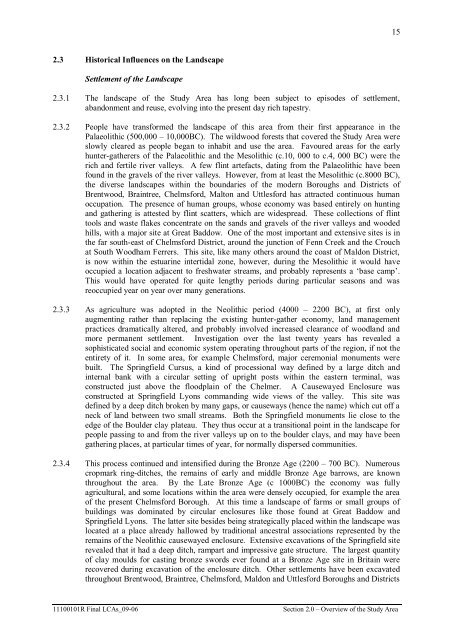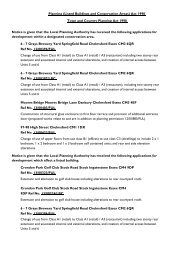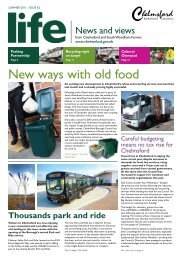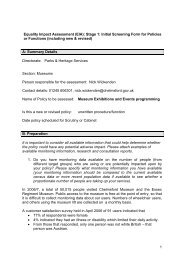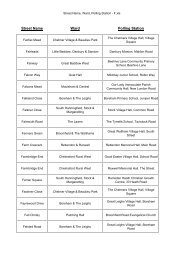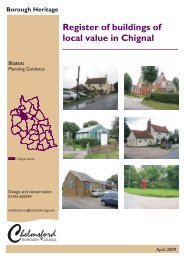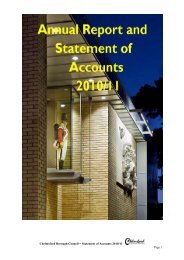142.2.22 The Essex Estuaries cSAC is a large estuarine site forming the eastern coastal boundary ofthe Study Area. It is a typical, undeveloped, flat low lying coastal plain estuarine systemwith associated open coast mudflats and sandbanks. The site comprises the major estuariesof the Blackwater, Crouch and Roach rivers and is important as an extensive area ofcontiguous estuarine habitat. Essex Estuaries also contains a very wide range ofcharacteristic marine and estuarine sediment communities and some diverse and unusualmarine communities in the lower reaches.2.2.23 Blackwater Estuary is the largest estuary in Essex north of the Thames and one of the largestestuarine complexes in East Anglia. Fringed by saltmarsh, its mudflats, on the upper shores,support internationally and nationally important numbers of over wintering waterfowl. Theseawall, ancient grazing marsh, associated fleet and ditch systems and semi-improvedgrassland are all of high conservation interest.2.2.24 Dengie SPA is located on the coast. It is a large remote area of tidal mud-flats andsaltmarshes at the eastern end of the Dengie Peninsula, between the adjacent Blackwater andCrouch Estuaries. The saltmarsh is the largest continuous example of its type in Essex.Foreshore, saltmarsh and beaches support an outstanding assemblage of rare coastal flora.2.2.25 The Crouch and Roach Estuaries SPA are located on the southeast coast of the Study Area.The River Crouch occupies a shallow valley between two ridges of London Clay, whilst theRiver Roach is set predominantly between areas of brick earth and loams with patches ofsand and gravel. The intertidal zone along the Rivers Crouch and Roach is 'squeezed'between the sea walls along both banks and the river channel. Unlike more extensiveestuaries elsewhere in Essex, there is only a relatively narrow strip of tidal mud which,nonetheless, is used by significant numbers of birds.Fresh Water and Open Water Habitats2.2.26 A complex of rivers and streams flow across the Study Area, many of which have beenmodified for flood alleviation or drainage. The rivers support a varied aquatic and emergentflora and scarce plants such as along the River Ter SSSI, west of Terling. Chalk rivers in thenorthwest of the Study Area are particularly rich in species.2.2.27 A number of animal species occur in the rivers, including the freshwater pea mussel, thewhite clawed crayfish, otters and water voles. The river corridors also provide rich foraginghabitats for many of the ten species of bat recorded in East of England.2.2.28 There are flooded gravel pits, clay pits and reservoirs in the Study Area, forming significantlandscape features. The artificial water bodies have a wide range of water and substratetypes, with a corresponding variety of aquatic plants. One example is Glemsford Pits SSSIcomprising a series of water-filled disused gravel workings and a length of the River Stour onthe Essex/Suffolk border.2.2.29 Hanningfield Reservoir SSSI, approximately 5 miles south of <strong>Chelmsford</strong>, is the secondlargest reservoir in Essex. Its main scientific interest lies in its breeding and winteringwildfowl.2.2.30 Most natural bodies of open water in the Study Area are eutrophic (rich in nutrients) ormesotrophic/eutrophic (medium – rich in nutrients). Small ponds and lakes are alsoabundant.Section 2.0 – Overview of the Study Area11100101R Final LCAs_09-06
152.3 Historical Influences on the <strong>Landscape</strong>Settlement of the <strong>Landscape</strong>2.3.1 The landscape of the Study Area has long been subject to episodes of settlement,abandonment and reuse, evolving into the present day rich tapestry.2.3.2 People have transformed the landscape of this area from their first appearance in thePalaeolithic (500,000 – 10,000BC). The wildwood forests that covered the Study Area wereslowly cleared as people began to inhabit and use the area. Favoured areas for the earlyhunter-gatherers of the Palaeolithic and the Mesolithic (c.10, 000 to c.4, 000 BC) were therich and fertile river valleys. A few flint artefacts, dating from the Palaeolithic have beenfound in the gravels of the river valleys. However, from at least the Mesolithic (c.8000 BC),the diverse landscapes within the boundaries of the modern <strong>Borough</strong>s and Districts ofBrentwood, Braintree, <strong>Chelmsford</strong>, Malton and Uttlesford has attracted continuous humanoccupation. The presence of human groups, whose economy was based entirely on huntingand gathering is attested by flint scatters, which are widespread. These collections of flinttools and waste flakes concentrate on the sands and gravels of the river valleys and woodedhills, with a major site at Great Baddow. One of the most important and extensive sites is inthe far south-east of <strong>Chelmsford</strong> District, around the junction of Fenn Creek and the Crouchat South Woodham Ferrers. This site, like many others around the coast of Maldon District,is now within the estuarine intertidal zone, however, during the Mesolithic it would haveoccupied a location adjacent to freshwater streams, and probably represents a ‘base camp’.This would have operated for quite lengthy periods during particular seasons and wasreoccupied year on year over many generations.2.3.3 As agriculture was adopted in the Neolithic period (4000 – 2200 BC), at first onlyaugmenting rather than replacing the existing hunter-gather economy, land managementpractices dramatically altered, and probably involved increased clearance of woodland andmore permanent settlement. Investigation over the last twenty years has revealed asophisticated social and economic system operating throughout parts of the region, if not theentirety of it. In some area, for example <strong>Chelmsford</strong>, major ceremonial monuments werebuilt. The Springfield Cursus, a kind of processional way defined by a large ditch andinternal bank with a circular setting of upright posts within the eastern terminal, wasconstructed just above the floodplain of the Chelmer. A Causewayed Enclosure wasconstructed at Springfield Lyons commanding wide views of the valley. This site wasdefined by a deep ditch broken by many gaps, or causeways (hence the name) which cut off aneck of land between two small streams. Both the Springfield monuments lie close to theedge of the Boulder clay plateau. They thus occur at a transitional point in the landscape forpeople passing to and from the river valleys up on to the boulder clays, and may have beengathering places, at particular times of year, for normally dispersed communities.2.3.4 This process continued and intensified during the Bronze Age (2200 – 700 BC). Numerouscropmark ring-ditches, the remains of early and middle Bronze Age barrows, are knownthroughout the area. By the Late Bronze Age (c 1000BC) the economy was fullyagricultural, and some locations within the area were densely occupied, for example the areaof the present <strong>Chelmsford</strong> <strong>Borough</strong>. At this time a landscape of farms or small groups ofbuildings was dominated by circular enclosures like those found at Great Baddow andSpringfield Lyons. The latter site besides being strategically placed within the landscape waslocated at a place already hallowed by traditional ancestral associations represented by theremains of the Neolithic causewayed enclosure. Extensive excavations of the Springfield siterevealed that it had a deep ditch, rampart and impressive gate structure. The largest quantityof clay moulds for casting bronze swords ever found at a Bronze Age site in Britain wererecovered during excavation of the enclosure ditch. Other settlements have been excavatedthroughout Brentwood, Braintree, <strong>Chelmsford</strong>, Maldon and Uttlesford <strong>Borough</strong>s and Districts11100101R Final LCAs_09-06Section 2.0 – Overview of the Study Area
- Page 1: BRAINTREE, BRENTWOOD, CHELMSFORD,MA
- Page 6 and 7: 8.0 RECOMMENDATIONS8.1 General8.2 K
- Page 8 and 9: EXECUTIVE SUMMARYBackgroundIn Octob
- Page 10 and 11: Executive Summary iv 11100101R Fina
- Page 13 and 14: 11.0 INTRODUCTION1.1 Background and
- Page 15 and 16: 3spatial planning approach should b
- Page 17 and 18: 5Proposals Map - expresses geograph
- Page 19 and 20: 7 View types and composition Landma
- Page 21 and 22: 9 the highlighting of landscape iss
- Page 23: 2.0 OVERVIEW OF THE STUDY AREA
- Page 26 and 27: 122.2.8 On the hills above the Lond
- Page 30 and 31: 16and have been found to have been
- Page 32 and 33: 18 Medieval settlement, in the pari
- Page 34 and 35: 20Historic Environment Designations
- Page 36 and 37: 22and drainage of other coastal wet
- Page 38 and 39: 24character. Upgrading of the rail
- Page 40 and 41: 26alternative sources from outside
- Page 42 and 43: 282.5.7 Together with the Joint Cha
- Page 44 and 45: 302.5.13 The seventy Landscape Char
- Page 46 and 47: 32Section 2.0 - Overview of the Stu
- Page 49 and 50: 1395.0 LANDSCAPE CHARACTER OF CHELM
- Page 51 and 52: 141A6 UPPER CHELMER RIVER VALLEY (s
- Page 53 and 54: 143 Fourteen CWSs with unimproved g
- Page 55 and 56: 145A7 LOWER CHELMER RIVER VALLEY (s
- Page 57 and 58: 147Suggested Landscape Planning Gui
- Page 59 and 60: 149to designed character and sense
- Page 61 and 62: 1515.3 Farmland Plateau Landscapes5
- Page 63 and 64: 153and Good Easter in the lower lyi
- Page 65 and 66: 155B16 FELSTED FARMLAND PLATEAU (sh
- Page 67 and 68: 157B17 TERLING FARMLAND PLATEAU (sh
- Page 69 and 70: 159B20 WRITTLE FARMLAND PLATEAUKey
- Page 71 and 72: 161Proposed Landscape Strategy Obje
- Page 73 and 74: 163Visual Characteristics. The A12
- Page 75 and 76: 1655.4 Drained Estuarine Marsh Land
- Page 77 and 78: 167well screened in the landscape.
- Page 79 and 80:
1695.5 Wooded Farmland Landscapes5.
- Page 81 and 82:
171enclosure and tranquillity and a
- Page 83 and 84:
173F6 WOODHAM WOODED FARMLAND (shar
- Page 85 and 86:
175enclosed meadows within river va
- Page 87 and 88:
177north, south and east. Therefore
- Page 89 and 90:
179F10 HEYBRIDGE WOODED FARMLAND (s
- Page 91 and 92:
181Suggested Landscape Planning Gui
- Page 93 and 94:
183and Ramsden Heath). Church tower
- Page 95 and 96:
185F12 EAST HANNINGFIELD WOODED FAR
- Page 97 and 98:
187 Potential major road improvemen
- Page 99 and 100:
189Historic Land UseEvidence of his
- Page 101:
8.0 RECOMMENDATIONS
- Page 104 and 105:
3428.2.3 Planners, developers, arch
- Page 106 and 107:
344Drafting Core Policies and Suppo
- Page 108 and 109:
346 Make the link between planning
- Page 110 and 111:
348 change in the degree of key fac
- Page 112 and 113:
350Section 8.0 - Recommendations111
- Page 115:
APPENDIX ASTAKEHOLDER CONSULTATION
- Page 118 and 119:
with the County assessment, but sho
- Page 120 and 121:
Fit with adjacent classificationsCB
- Page 122 and 123:
Chelmsford - Key threats to valued
- Page 124 and 125:
Appendix A - Stakeholder Consultati
- Page 126 and 127:
CBA gave a brief overview of the st
- Page 128 and 129:
9. Summary and Recommendations/Appl
- Page 130 and 131:
development planning with conservat
- Page 133 and 134:
GLOSSARYCommunity StrategyAll local
- Page 135:
APPENDIX CSOURCES OF FURTHER INFORM
- Page 138 and 139:
English Heritage, 2003, Register of
- Page 141 and 142:
HISTORIC LANDSCAPE CHARACTER AREAS
- Page 143:
APPENDIX ECURRENT LOCAL PLANNING SI
- Page 146 and 147:
Appendix E - Current Local Planning
- Page 149 and 150:
APPENDIX FDRAFT CORE STRATEGY LANDS
- Page 151:
cbawww.cba.uk.netLondon OfficeSwan


